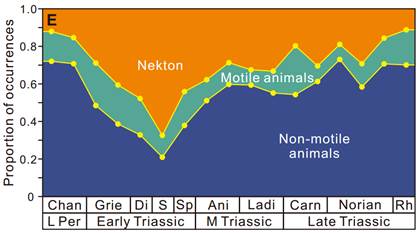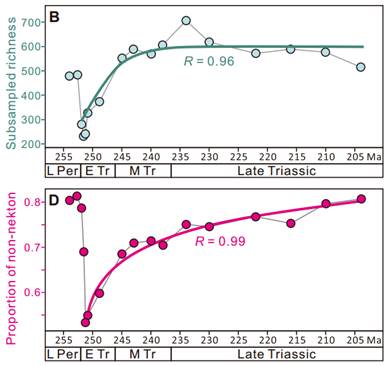Abstract
The Permian-Triassic mass extinction was the worst crisis faced by life; it killed >90% of marine species in less than 0.1 million years (Ma). However, knowledge of its macroecological impact over prolonged time scales is limited. We show that marine ecosystems dominated by non-motile animals shifted to ones dominated by nektonic groups after the extinction. In Triassic oceans, animals at high trophic levels recovered faster than those at lower levels. The top-down rebuilding of marine ecosystems was still underway in the latest Triassic, ~50 Ma after the extinction, and contrasts with the ~5-Ma recovery required for taxonomic diversity. The decoupling between taxonomic and ecological recoveries suggests that a process of vacant niche filling before reaching the maximum environmental carrying capacity is independent of ecosystem structure building.

Functional pyramids in generic diversity among non-motile, motile, and nektonic groups from four geological intervals, indicating a reversed pyramid in the Early Triassic. The size of proportions is represented by the area of the triangles.

(E) Proportion of marine generic occurrences among non-motile, motile, and nektonic groups.

(B) Subsampled generic richness in time bins. The data are the same subsampled generic richness as shown in (A) but in different time scaling. Green curve shows a logistic increase (R = 0.96, P ≪ 0.001) from Dienerian to Rhaetian.
(D) Proportion of non-nektonic animals based on subsampled data in (C). Magenta curve shows a logarithmic increase (R = 0.99, P ≪ 0.001) from Dienerian to Rhaetian.
Title: Decoupled taxonomic and ecological recoveries from the Permo-Triassic extinction
Authors: Haijun Song*, Paul B. Wignall, Alexander Dunhill
Source: Science Advances (2018)
DOI: 10.1126/sciadv.aat5091
Published: October 10, 2018
Link to the paper: http://advances.sciencemag.org/content/4/10/eaat5091